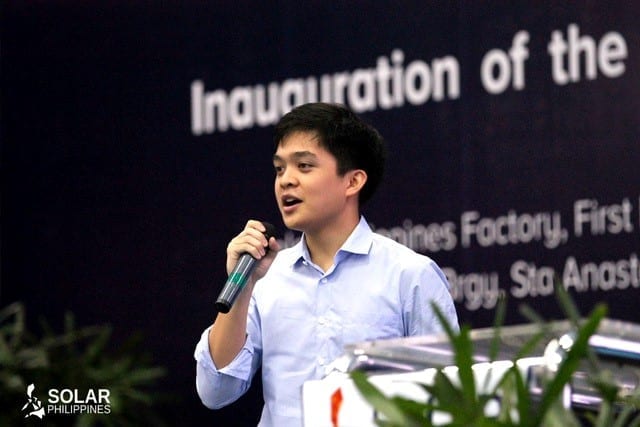
Leandro Leviste is the President and CEO of Solar Philippines, a company he founded in 2013 and is today’s largest solar company in Southeast Asia’s. He shares the business model and strategy of Solar Philippines
Q1: On Target Market – What made you choose the commercial / industrial segment over the residential segment first?
A: Commercial projects have economies of scale, which help lower costs for residential projects. Installing solar on mall rooftops also raises consumer awareness, and as there are only a few large rooftops, there’s more urgency to move early into commercial. That said, we believe in the importance of participating in diverse market segments, because residential will surpass commercial in scale in the coming years, and meanwhile, operations in each segment help scale and complement each other.
Q2: On Value Proposition – You offer no upfront investment and guaranteed cost savings vs. Meralco. What competitive differentiation or one-word would you want to own before more competition comes in?
A: A Meralco executive once told me, “Only three things matter in our selecting power suppliers: Price, price, and price.” While other factors are also important, electricity is ultimately a commodity that consumers want at the lowest cost. By vertically integrating manufacturing, construction, development, and operations, we generate solar cheaper than any other power source in the Philippines, lowering the cost of electricity and contributing to economic development.
That said, we believe solar’s strongest value proposition is in provinces that suffer daily brownouts or lack electricity, and instead of merely savings, we offer a whole new experience: the benefits of electricity itself. By bringing reliable 24/7 power to certain provinces for the first time in history, we address a great need and enter markets where there is less or no competition, as the private sector traditionally neglects provinces in favor of metropolitan areas.
Q3: On Channel – There are a lot of inefficiencies in marketing solar services. Potential customers don’t get a proposal overnight because of the need to climb and measure rooftops. There are also a lot of time and efforts wasted on proposals that are not turned into contracts. How are you addressing this in the pre-sale portion of your distribution?
A: Henry Ford said, “Any customer can have a car painted any color that he wants, so long as it is black.” Standardizing products and simplifying sales processes is key to scaling solar to every rooftop. Software also enables our engineers and salespeople to serve more customers.
Yet less than 1% of Filipino rooftops have solar as of today, and even in the world’s most advanced solar markets, no more than 20% of households have switched to solar, even if all would benefit from doing so. Selling and installing rooftop solar has inherent challenges to scale, and needs more revolutionary steps forward to reach 100% of households. These may consist of “Building Integrated Photovoltaics” (BIPV), like Tesla’s newly introduced solar roof tiles, and solar micro-grids which would enable entire communities to go solar together.
Q4: On Revenue Model – You intend to generate a lock-in revenue model based on the bank financing your equipments. But banks require a certain asset to liability ratio. Given your expansion plan, why do you think banks, which usually offer higher rates, would be the best way to go?
A: Consumers are accustomed to paying for electricity over time, instead of buying their next 25 years worth of electricity all at once, which is what paying for solar panels effectively is. Enabling consumers to avail of solar at zero upfront cost is thus essential for mainstream adoption, especially now that a consumer saves more from a solar system than its monthly amortization, meaning solar makes sense and is accessible to every Filipino.
We are currently financing our projects in partnership with local banks, and interest expense is now an even larger component of a project’s cost than the solar panels themselves. But as banks gain more familiarity with the asset class, financing solar projects in the Philippines should become simpler and more cost-effective, as has been the case in developed markets.
Q5: On Customer Bonding – How are you taking care of existing customers?
A: We recently launched a dealership and referral program, and many of the participants are our existing customers. Referrals are the most effective sales channel, and it’s paramount that our customers be satisfied, because the positive experience of early customers is key for solar to become mainstream.
Q6: On Value Network – Are you focusing on supplying solar during peak hours? How long does it take Meralco to install a net metering scheme after a customer sign up for your services?
A: Solar’s peak supply coincides with hours of overall peak demand, as businesses operate during the day. Residential consumption however drops during these hours, necessitating Net Metering to export excess energy to the grid. Net Metering has two problems: it has typically taken months to process an application, and exports are only credited at the generation rate equal to around 40% of the full electricity rate. In light of this, only a fraction of Filipino households with solar have bothered to avail of Net Metering, and the economics already favor storing excess energy in batteries rather than exporting fully to the grid.
Q7: On Resources – Installation is one of the toughest areas in the business of solar equipment. Margins go up and down depending on installation experience. How are you compared to the standard time in installing a solar panel worldwide?
A: Achieving the lowest costs of installation remains a challenge, because quality is doubly important when installing systems backed by long-term warranties and a company’s reputation. Certain installers can offer lower costs by cutting corners and forgoing warranties, but most consumers recognize the value in going with companies that can stand by their warranties, especially for a big ticket purchase of a 25-year product.
Q8: On Processes – Old roofs can leak and interfere with your customer’s operation after you install your equipment. How do you mitigate this potential risk?
A: Solar roof mounting structures are designed to prevent leaks, and our rooftop installations have thus far not caused any leaks. The problem is when installing solar on roofs that already leaks, in which case we advise not proceeding with the installation at that time. This limits the size of the immediately addressable market, at least until the roof is replaced or if installing solar roof material is made the project in itself.
Q9: On Complementors – In other countries, there are many government rebates and incentives to switch. How is Philippines doing in this area?
A: The Renewable Energy Law gave us Net Metering, but utilities have interpreted the rules to credit only the generation charge, equal to only around 40% of the full electricity rate (unlike in other countries). This inadvertently incentives consumers to install batteries to store the energy instead of export to the grid, encouraging Filipinos to become independent from electric utilities.
This highlights the broader point, that because of the high cost of electricity in the Philippines, solar and battery economics already works even without government incentives, and that solar will find its way to reach every Filipino notwithstanding whatever policies may be.
Q10: On Vision – How do you see Solar Philippines transforming in the next 5 years?
A: Solar is now the world’s cheapest form of energy, and with storage can already supply the majority of the world’s demand. This makes it possible for countries like the Philippines to lower electricity rates, make reliable power universally accessible, and accelerate their economic development. That said, the industry hasn’t grown nearly as fast as the potential suggests, because of a lack of scale, efficiency, and long-term commitment.
We are committed to realizing solar’s potential in the Philippines, supplying the grid with the lowest cost energy, and helping consumers access solar rooftops and community micro-grids. We are particularly passionate about bringing solar to provinces with poor electric service, which the private sector traditionally ignores, to help unlock the potential of the Philippine countryside, and serve as jump-off point for Filipino products to help power rural areas worldwide.



Great article!